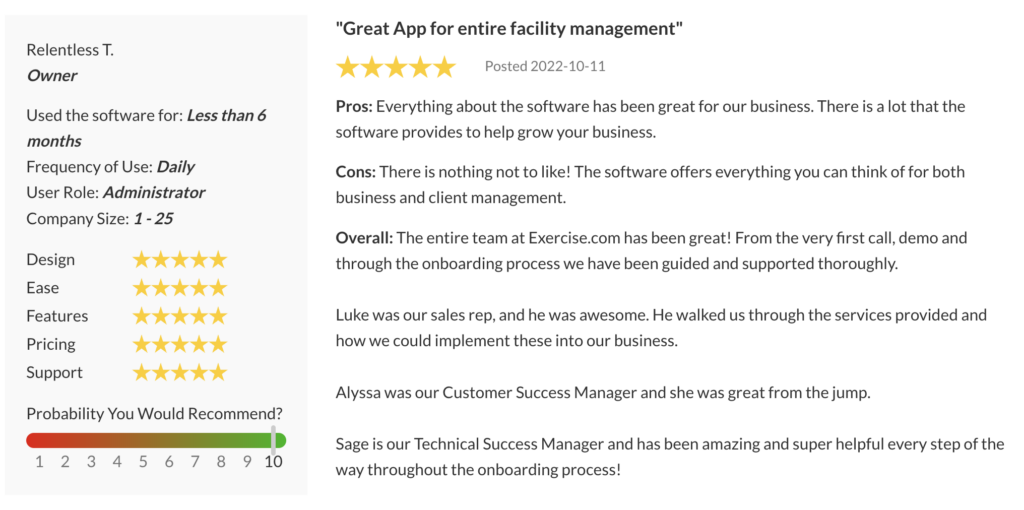19 Problems in the Fitness Industry in 2025
Yes, there are problems in the fitness industry, and stating them frankly is the first step to solving them. Read on for the most common problems in the fitness industry, and how to solve them.

The fitness industry is undoubtedly booming, with more individuals than ever before prioritizing their health and well-being. However, amidst the abundance of gym memberships, fitness classes, and personal trainers, there are a plethora of fitness industry problems plaguing the industry.
In this article, we will explore the various fitness industry challenges, from lack of regulation to inadequate training and certification, and uncover the need for change and improvement.
And if you are ready to take your gym or fitness business to the next level then this is just another reason Exercise.com’s best gym business management software and best personal training business management software helps grow your business!

And as our reviews from gym owners attest, we love gym owners and they love us. Read our gym owner guide and then see why our gym software has gym owners raving (get a free demo here).

Create workout plans with a workout plan creator.

Communicate with gym members, leads, and online followers via SMS, email, and in-app push notification.

And of course, view all of your gym business reports easily too.

All from your custom-branded fitness apps (Read More: Best Gym Mobile Fitness Apps Software)

You can grow your business by selling workout plans, using our white label fitness app builder software to offer a custom branded fitness app, learning how to run an online fitness challenge, and much more.

Problem #1 – Lack of Regulation: Challenges in Ensuring Standards
One of the primary issues in the fitness industry is the lack of regulation, which poses significant challenges in ensuring standards across the board. Unlike other industries that are tightly regulated to protect consumers, the fitness industry operates with a considerable degree of autonomy. While there are organizations and certifications available, the absence of mandatory regulations allows for inconsistent quality and varying expertise among trainers and fitness facilities.
This lack of regulation has significant implications for the safety and well-being of fitness enthusiasts. Without standardized guidelines, there is a higher risk of injuries and accidents due to inadequate equipment, improper training techniques, and negligence. Furthermore, the absence of regulation leaves consumers vulnerable to deceptive practices and ineffective programs that may do more harm than good.
Problem #2 – Misleading Marketing Tactics: Deceptive Claims and False Promises
Another troubling trend in the fitness industry is the prevalence of misleading marketing tactics, often used to lure in consumers with deceptive claims and false promises. From fad diets promising rapid weight loss to workout gadgets guaranteeing sculpted bodies in just minutes a day, the abundance of unsubstantiated claims creates unrealistic expectations and perpetuates a cycle of disappointment and frustration for individuals seeking genuine health and fitness solutions.
The need for evidence-based information and transparent advertising cannot be overstated. It is imperative for fitness professionals and businesses to prioritize education and honest marketing practices that promote sustainable and realistic goals. This shift in approach will empower consumers to make informed decisions and avoid falling victim to empty promises.
Problem #3 – Lack of Industry Oversight: The Need for Accountability
A critical issue in the fitness industry is the lack of industry oversight and accountability. Without a governing body or regulatory agency to monitor practices and address misconduct, there is little incentive for fitness businesses and professionals to prioritize ethical behavior or address grievances effectively.
This lack of accountability not only harms consumers but also contributes to the erosion of trust within the industry. It is crucial for the fitness industry to establish effective mechanisms for reporting grievances, resolving disputes, and holding businesses and professionals accountable for their actions. This could involve the establishment of industry-wide standards, the creation of a centralized complaint system, and the implementation of disciplinary measures for misconduct.
Problem #4 – Inadequate Training and Certification: Putting Consumers at Risk
An alarming problem within the fitness industry is the insufficiency of training and certification required for individuals to become fitness professionals. While there are reputable organizations that offer comprehensive certification programs, there is no universal standard for the knowledge and skills required to be a competent fitness trainer.
This lack of standardized training puts consumers at risk as they may unknowingly engage with trainers who lack the knowledge and expertise to design safe and effective exercise programs. Additionally, inadequate training can lead to improper form and technique, increasing the likelihood of injuries.
A comprehensive and standardized training and certification process is essential to guarantee the competence and professionalism of fitness professionals. By setting universal standards, the industry can ensure that individuals seeking fitness guidance receive accurate information, safe exercise instruction, and personalized programs tailored to their specific needs and goals.
Problem #5 – Unqualified Trainers: The Dangers of Incompetence
Building on the issue of inadequate training and certification, the presence of unqualified trainers within the fitness industry further compounds the problems faced by consumers. Unqualified trainers lack the necessary knowledge, experience, and skills to guide individuals properly, increasing the risk of injury and hindered progress.
Without proper qualification requirements, anyone can claim to be a fitness expert, leading to a flood of unqualified trainers in the market. This compromises the reputation of the industry as a whole and undermines the trust of consumers.
To address this issue, it is imperative for the fitness industry to establish stringent qualification criteria and enforce them rigorously. By ensuring that only qualified and competent trainers are allowed to practice, consumers can have confidence in the expertise and credibility of the trainers they choose to work with.
Ready to make sure that choosing the best gym management software and the best personal training software isn’t a problem for your fitness business?

Problem #6 – Exorbitant Costs: Pricing Out the Average Consumer
For many individuals, the cost of fitness can be a significant barrier to entry. The exorbitant costs associated with gym memberships, fitness classes, and personal training sessions often price out the average consumer, making it difficult for them to prioritize their health and well-being.
The high prices within the fitness industry are a result of various factors, including the cost of equipment, facility maintenance, and personnel. However, the emphasis on profit margins and commercialization has also contributed to inflated prices.
To address this problem, the fitness industry needs to explore more accessible and affordable options without compromising quality. This could involve community-based fitness initiatives, subsidized fitness programs, and the development of cost-effective alternatives for individuals who cannot afford traditional fitness offerings.
Problem #7 – Lack of Accessibility: Limited Options for Different Demographics
The lack of accessibility within the fitness industry is a prevalent problem, as it limits options for different demographics. Traditional fitness facilities and programs often fail to cater to individuals with diverse needs, including those with disabilities, older adults, and individuals from marginalized communities.
To address this issue, the industry needs to prioritize inclusivity and make fitness accessible for everyone. This includes offering specialized programs and facilities that accommodate individuals with physical limitations, providing culturally sensitive and gender-inclusive spaces, and ensuring that fitness professionals receive training in addressing the unique needs of diverse populations.
Problem #8 – Unrealistic Body Image Ideals: The Negative Impact on Mental Health
The fitness industry has long been criticized for perpetuating unrealistic body image ideals, contributing to body dissatisfaction, low self-esteem, and poor mental health. The relentless promotion of a specific aesthetic standard not only places immense pressure on individuals but also creates a toxic culture that focuses solely on appearance rather than holistic well-being.
It is crucial for the fitness industry to embrace a more inclusive and body-positive approach that celebrates diversity and promotes overall health and happiness. By shifting the narrative away from aesthetics and towards overall well-being, individuals can develop a healthier relationship with fitness, exercise, and their bodies.
Problem #9 – Overemphasis on Aesthetics: Neglecting Overall Well-being
A related problem in the fitness industry is the overemphasis on aesthetics, which often leads to the neglect of overall well-being. Many fitness programs and trainers prioritize weight loss, muscle gain, and physical appearance above factors such as mental health, flexibility, mobility, and cardiovascular fitness.
To address this issue, there needs to be a shift towards a more holistic approach to fitness. This includes prioritizing mental health, promoting functional fitness, and encouraging a well-rounded approach that encompasses physical, emotional, and social well-being.
Problem #10 – Lack of Diversity and Inclusion: Addressing the Industry’s Exclusivity
The fitness industry has historically been exclusive, failing to represent and cater to diverse populations. This lack of diversity not only perpetuates systemic inequalities but also limits the effectiveness of fitness programs and initiatives.
It is essential for the industry to actively address and rectify this issue by embracing diversity and promoting inclusivity. This involves actively recruiting fitness professionals from diverse backgrounds and cultures, providing culturally sensitive fitness programs, and creating safe and inclusive spaces for individuals from all walks of life.
Problem #11 – Unsafe Practices and Equipment: Prioritizing Safety Measures
Ensuring the safety of fitness enthusiasts should be a top priority within the industry. However, many fitness facilities and professionals fail to prioritize safety measures, thus endangering individuals who engage in physical activity.
Unsafe practices, such as improper equipment maintenance, lack of proper training supervision, and inadequate safety protocols, contribute to a higher risk of injuries. It is imperative for fitness facilities and professionals to prioritize safety by implementing strict safety protocols, conducting regular equipment maintenance, and providing knowledgeable supervision and guidance to individuals.
Problem #12 – Lack of Personalized Approach: Failing to Tailor Fitness Programs to Individuals
Personalization is a crucial aspect of fitness that is often overlooked within the industry. Many fitness programs and trainers adopt a one-size-fits-all approach, neglecting the unique needs, preferences, and goals of individuals.
By failing to tailor fitness programs to individuals, the industry limits progress and hinders the overall effectiveness of exercise programs. It is essential for fitness professionals to adopt a personalized approach, understand their clients’ specific needs and goals, and create individualized exercise programs that maximize results and promote engagement and adherence.
Problem #13 – Inconsistent Quality Control: Ensuring Consistency across Gyms and Studios
Consistency in quality across gyms and studios is a notable problem within the fitness industry. While some establishments prioritize high standards and exceptional service, others fall short in terms of cleanliness, equipment maintenance, and customer support.
The lack of consistent quality control undermines the reputation of the fitness industry as a whole. To address this issue, there needs to be a concerted effort to establish standardized guidelines for hygiene, equipment maintenance, and customer service. Additionally, regular inspections and assessments could be implemented to ensure compliance with these standards.
Problem #14 – Over-reliance on Supplements and Quick Fixes: Rethinking Long-term Health Strategies
Supplements and quick fixes have become pervasive within the fitness industry, promising instant results and effortless transformations. However, relying solely on these shortcuts undermines the importance of sustainable, long-term health strategies.
The emphasis should be on promoting a balanced, whole-foods-based diet and adopting sustainable lifestyle habits rather than relying on supplements and shortcuts. Fitness professionals and businesses should prioritize educating consumers about the importance of consistent effort, patience, and realistic expectations.
Problem #15 – Exploitative Business Models: Unfair Contracts and Hidden Fees
Exploitative business models are another concern within the fitness industry. Many fitness facilities and programs employ unfair contracts, hidden fees, and aggressive sales tactics to maximize profit at the expense of consumer trust and satisfaction.
The fitness industry should prioritize transparency, honesty, and fair business practices. Contracts and pricing structures should be clear and free of hidden fees, and businesses should strive to cultivate strong relationships with their customers based on mutual trust and respect.
Problem #16 – Insufficient Support for Physical Rehabilitation: Bridging the Gap between Fitness and Rehabilitation Industries
The integration of physical rehabilitation and fitness is an area that requires significant improvement within the industry. Individuals with physical injuries or chronic conditions often struggle to find adequate support and guidance in transitioning from rehabilitation to regular fitness programs.
By bridging the gap between the rehabilitation and fitness industries, individuals can receive the necessary support and guidance to safely and effectively transition from rehabilitation to long-term fitness. Collaborative efforts between fitness professionals, physical therapists, and medical professionals can ensure a seamless continuum of care for individuals seeking to regain their health and fitness.
Problem #17 – Over-commercialization of Fitness Culture: Balancing Profitability and Ethical Practices
The fitness industry has become increasingly commercialized, with profit-driven motives often taking precedence over ethical practices. This can lead to the prioritization of profit margins over the well-being of consumers, creating an environment that values quantity over quality.
To address this issue, the industry must strike a balance between profitability and ethical practices. By placing an emphasis on providing high-quality services, prioritizing customer satisfaction, and promoting long-term health outcomes, the fitness industry can build a reputation based on trust and integrity.
Problem #18 – Workplace Issues in the Fitness Industry: Addressing Employee Exploitation
Employee exploitation is a prevalent problem within the fitness industry. Many fitness professionals, particularly those working on an hourly or commission basis, face unstable employment, negligible benefits, and inadequate compensation.
To address this issue, fitness businesses need to prioritize fair employment practices, including fair compensation, benefits, and opportunities for professional development. By creating a supportive and inclusive work environment, businesses can attract and retain qualified fitness professionals who are dedicated to the well-being of their clients.
Problem #19 – Environmental Sustainability in Fitness Facilities: Promoting Eco-friendly Practices
The fitness industry’s impact on the environment cannot be underestimated. From energy consumption to waste generation, fitness facilities contribute to environmental degradation.
It is vital for the industry to prioritize environmental sustainability by implementing eco-friendly practices such as energy-efficient equipment, waste recycling programs, and the use of sustainable materials. By promoting an environmentally conscious approach, the fitness industry can positively contribute to the well-being of both individuals and the planet.
As we have explored in this article, the fitness industry faces numerous problems that can impact the safety, well-being, and satisfaction of consumers. From lack of regulation and inadequate training to misleading marketing tactics and the overemphasis on aesthetics, these challenges highlight the need for change and improvement within the industry. By addressing these issues and prioritizing consumer needs, the fitness industry can transform itself into a trusted and inclusive space that promotes the overall health and well-being of individuals.
Ready to make sure that choosing the best gym management software and the best personal training software isn’t a problem for your fitness business?

What are some problems in fitness industry publications that seem to be mentioned but glossed over and not adequately addressed?
A significant problem in fitness industry publications is the superficial treatment of critical issues like body image, mental health, and the long-term impacts of extreme fitness regimens. These topics are often mentioned but not deeply explored, leading to a lack of comprehensive understanding among fitness professionals. Additionally, there is a tendency towards promoting trendy diets and workouts, sometimes at the expense of sustainable and scientifically backed fitness practices. This approach can create unrealistic expectations for both clients and trainers, fostering a culture focused more on quick results rather than long-term health and wellness.
What is the biggest fitness problem faced by personal trainers first starting their career training clients?
The biggest challenge for personal trainers starting their career is often client acquisition and retention. New trainers might struggle to build a client base in a competitive market. Establishing trust and demonstrating value to potential clients can be challenging without a strong reputation or track record. Additionally, managing the administrative side of personal training, like scheduling, tracking client progress, and handling payments, can be overwhelming for those new to the business.
For managing these aspects, a platform like Exercise.com with the best personal training management software can be invaluable. It streamlines administrative tasks, allowing trainers to focus more on client interaction and program development. Its features for scheduling, client management, and payment processing can significantly ease the burden for trainers starting their career.
What are some gaps in the fitness market that fitness entrepreneurs should help serve?
Fitness entrepreneurs should address the gap in personalized and inclusive fitness offerings. There’s a growing demand for programs that cater to diverse populations, including older adults, people with disabilities, and those with chronic health conditions. Additionally, the market lacks sufficient focus on holistic health approaches that integrate mental and physical wellness. Tailoring programs to meet these specific needs can create opportunities for entrepreneurs in the fitness industry.
Are the problems with the fitness industry getting better or worse?
The fitness industry’s problems are evolving. While there’s increasing awareness about issues like inclusivity and sustainable fitness practices, challenges like misinformation, the promotion of unrealistic body standards, and the commodification of health and wellness persist. The rise of social media and online platforms has both alleviated and exacerbated these issues by improving access to information but also spreading unverified and potentially harmful fitness trends.
What are the most common ethical issues in the fitness industry?
Common ethical issues in the fitness industry include the promotion of unattainable or unhealthy body images, the sale of unnecessary or ineffective supplements and products, and the provision of advice outside the scope of a professional’s qualifications. There’s also a concern about privacy and the ethical handling of client data, especially in the digital age.
What are the most controversial gym topics?
Controversial gym topics often revolve around gym etiquette, the use of performance-enhancing substances, and debates over different training methodologies like high-intensity training versus traditional strength training. Discussions about inclusivity and accessibility in gym spaces also often generate significant debate.
What are some controversial topics in exercise science?
In exercise science, controversies include debates over the efficacy and safety of various diet and exercise regimens, like ketogenic diets or extreme endurance training. The role of genetics versus environment in fitness and athletic performance is also a contentious area. Additionally, the long-term impacts of emerging fitness technologies and supplements frequently spark debate.
How is sustainability in the fitness industry being addressed?
Sustainability in the fitness industry is increasingly being addressed through eco-friendly gym equipment, sustainable building practices for fitness facilities, and promoting outdoor activities that have a lower environmental impact. The industry is also seeing a shift towards digital platforms that reduce the need for physical resources, contributing to a more sustainable model of fitness.
Explain why the fitness industry is broken from a critic’s perspective; now, how could the fitness industry be fixed?
From a critic’s perspective, the fitness industry is broken due to its focus on short-term results, promotion of unrealistic beauty standards, and the commodification of health. To fix this, the industry should emphasize sustainable, long-term health goals, promote body positivity and inclusivity, and prioritize evidence-based practices. Educating fitness professionals and consumers about the holistic aspects of health and wellness is also essential.
Is the fitness industry oversaturated?
The fitness industry may seem oversaturated with a high number of facilities, trainers, and online fitness solutions. However, there is still room for growth, especially in niche fitness markets and underserved communities. Differentiation and specialization can help businesses stand out in this crowded space.
What are the most exciting new fitness trends that fitness professionals should actually incorporate into how they live their daily lives?
Exciting fitness trends for professionals to incorporate include wearable fitness technology, functional fitness training, mindfulness and stress-reduction techniques, and personalized nutrition and workout regimes. Incorporating these trends can enhance their own health and provide a better understanding of emerging market dynamics.
How big is the fitness industry?
The fitness industry is a multi-billion-dollar global market, continuously growing with the increasing awareness of health and wellness. It encompasses a wide range of sectors, including gym and club memberships, fitness equipment, online fitness platforms, and wellness programs.
How big is the virtual fitness market?
The virtual fitness market has seen significant growth, especially following the COVID-19 pandemic. It includes online fitness classes, streaming workout programs, and fitness apps. This market expansion reflects the growing demand for convenient, home-based fitness solutions.
What are the top selling fitness products that fitness professionals should be aware of in their businesses?
Top selling fitness products include wearable technology like fitness trackers, home gym equipment like resistance bands and adjustable dumbbells, and wellness products like yoga mats and foam rollers. Fitness professionals should also be aware of emerging digital fitness solutions and supplements.
What are some common problems faced by gym beginners?
Gym beginners often face challenges like gym intimidation, uncertainty about using equipment correctly, and developing a consistent workout routine. They may also struggle with setting realistic fitness goals and understanding proper nutrition.
What are some common problems faced by gym goers who attend regularly?
Regular gym goers may encounter plateaus in their fitness progress, overtraining, or repetitive strain injuries. Staying motivated and continuously adapting their fitness routine to meet evolving goals can also be challenging.
What are some common problems with gym equipment?
Common problems with gym equipment include wear and tear from regular use, outdated or malfunctioning machines, and a lack of proper maintenance. Ensuring equipment safety and keeping up with technological advancements can also be challenging for gym owners.
What are the threats in the fitness industry?
The fitness industry faces several threats that can impact businesses within the sector. These threats include increased competition from new gyms or fitness studios entering the market, changing consumer preferences and behaviors, economic downturns affecting discretionary spending on fitness services, and shifts in technology that disrupt traditional gym and fitness business models. However, by leveraging comprehensive gym management software like Exercise.com, gyms and fitness businesses can better adapt to these challenges, streamline operations, and position themselves for growth and success in the ever-evolving fitness industry.
What’s lacking in the fitness industry?
While the fitness industry has made significant progress in recent years, some areas still require attention and improvement. One key area that is often highlighted is the need for more comprehensive and personalized fitness programming. This is where Exercise.com can make a significant impact by providing gyms and fitness businesses with the tools and resources to create tailored workout plans, offer online training programs, and track client progress. By offering customized fitness solutions, businesses can better meet the unique needs of their clients, enhance customer satisfaction, and differentiate themselves in a competitive market.
What are the common problems in the gym?
Gyms often face common problems that can impact their operations and success. These include member retention and attrition, maintaining a consistent and engaged customer base, managing facility maintenance and equipment upkeep, staffing and employee management, marketing and attracting new members, and balancing financial stability. With Exercise.com’s best gym management software, gyms can address these challenges effectively. The platform offers features such as member management, scheduling and booking, billing and payment processing, and marketing tools to streamline operations, enhance member experience, and optimize business performance.
Read More: Best Gym Booking Software
Is there a future in the fitness industry?
Yes, the fitness industry has a promising future, especially for gyms and fitness businesses that adapt to changing market demands and leverage technology to deliver innovative fitness solutions. Exercise.com offers gym owners the ability to create a custom branded fitness app, offer online training, sell workout plans and fitness products, and run fitness challenges. By embracing these digital solutions, gyms can extend their reach beyond physical locations, tap into the growing demand for online fitness services, and position themselves for future success in an increasingly digital and interconnected world.
What are the trends in the fitness industry?
Several fitness industry trends shape the fitness industry’s landscape. Some prominent trends include the rise of boutique fitness studios offering specialized workout experiences, the integration of technology and data-driven fitness solutions, the popularity of group fitness classes and community-based workouts, the emphasis on functional fitness and performance training, and the growing demand for virtual and on-demand fitness options. Exercise.com’s gym management software supports these trends by providing tools for managing group classes, offering virtual training sessions, tracking performance metrics, and facilitating community engagement. By aligning with these trends, gyms can stay relevant and meet the evolving needs of their clients.
What is the future of the health and fitness industry?
The future of the health and fitness industry is centered around providing personalized and holistic wellness experiences. Exercise.com’s platform empowers gyms and fitness businesses to deliver these experiences by enabling the creation of custom workout plans, offering nutrition tracking and meal planning, providing virtual training options, and integrating with wearable devices. By embracing this future-oriented approach and leveraging Exercise.com’s capabilities, gyms and fitness businesses can position themselves as comprehensive wellness destinations and cater to the evolving demands of health-conscious consumers.
What are the threats to personal trainer business?
Personal trainer businesses face various threats that can impact their success. Some of these threats include increased competition from other personal trainers or fitness professionals, clients’ changing preferences or availability, economic downturns affecting clients’ ability to invest in personal training services, and the potential for injury or liability concerns. Exercise.com’s online training platform offers personal trainers a solution to overcome these threats by enabling them to expand their reach beyond physical training sessions. Trainers can offer personalized training programs, track client progress remotely, and provide ongoing support and communication. By leveraging Exercise.com, personal trainers can enhance their services, broaden their client base, and mitigate some of the threats they may face in the industry.
What are some of the biggest problems in the fitness industry today?
The fitness industry faces several significant challenges. Key issues include misleading marketing tactics, which often involve deceptive claims and false promises, and a lack of regulation, leading to inconsistent standards across the industry. Another major concern is the lack of industry oversight, which is necessary for accountability. These problems in the fitness industry highlight the need for more stringent controls and ethical practices. Platforms like Exercise.com can help address these issues by providing reliable and transparent fitness management solutions.
How do gaps in the fitness industry and gym issues affect consumers?
Gaps in the fitness industry, such as inadequate training and certification of fitness professionals, put consumers at risk. Problems in the gym industry also include unqualified trainers, which can lead to unsafe practices and ineffective guidance. Additionally, gym problems like exorbitant costs and lack of accessibility limit options for different demographics, making fitness less inclusive. Addressing these fitness issues requires a concerted effort to improve standards and practices within the industry.
What is missing in the fitness industry, and how can it evolve?
What is missing in the fitness industry often revolves around a lack of personalized approach and diversity. The industry needs to move beyond an overemphasis on aesthetics and unrealistic body image ideals, focusing more on overall well-being and inclusivity. The future of fitness lies in embracing a more holistic approach, considering mental health, and promoting diversity and inclusion. Solutions like Exercise.com can aid in this evolution by offering tools that cater to a wide range of fitness needs and preferences.
What are some controversial fitness topics and ethical issues in the fitness industry?
Controversial fitness topics include the over-reliance on supplements and quick fixes, which often overshadow the importance of long-term health strategies. Ethical issues in the fitness industry, such as exploitative business models and workplace issues, also need urgent attention. These problems highlight the need for more ethical and sustainable practices in the fitness industry. Platforms like Exercise.com can play a role in promoting ethical practices by offering fair and transparent business solutions.
How do current fitness trends and events impact the fitness industry?
Current fitness trends and events, like the growing emphasis on current exercise trends and nutrition, are shaping the fitness industry’s future. However, it’s crucial to address current events on nutrition and fitness with a critical eye, ensuring that new trends are safe, effective, and inclusive. The industry must adapt to these trends while maintaining high standards and ethical practices. Exercise.com can support this adaptation by providing up-to-date tools and resources that align with the latest industry developments.











